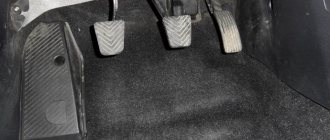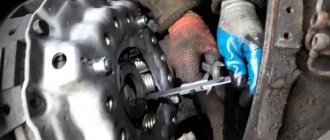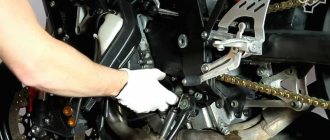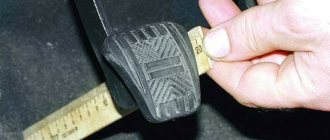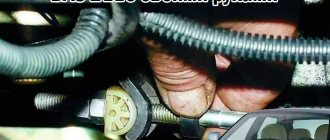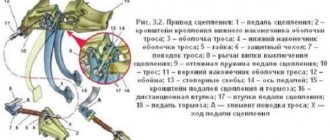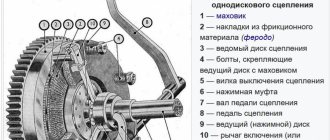Many novice drivers are interested in adjusting the Priora clutch, since problems with the clutch often arise when operating the car. It happens that while driving there are sounds in the form of clicks. These sounds can be removed by adjusting the clutch drive. The article describes in detail the adjustment of the cable and clutch pedal, so even a novice driver can perform these operations.
What should be the free play of the clutch pedal and how to measure it
This concept means the unimpeded movement of the pedal to the actuation point. At first, the leg will not feel any resistance, but after switching on, a certain stiffness will appear. This period of “relaxation” is called free movement.
The average norm is 160 millimeters. The range of acceptable values may vary. For each specific vehicle, technical requirements may vary.
An incorrectly adjusted freewheel can cause serious problems on the road.
Clutch parts will wear out more intensively. Therefore, to prevent unpleasant situations, it is recommended to periodically check the free play.
This should be done using the following algorithm:
- Press the clutch pedal all the way by hand, measure the distance from the floor to its pad using a regular ruler, setting it strictly vertically in relation to the floor surface.
- At the next stage, you need, on the contrary, to press this element back as much as possible and make the same measurements.
- Do simple calculations. Here you just need to subtract the smaller value from the larger number. This will be the amount of free play of the clutch. The norm is 12-14 centimeters. If measurements give readings that fall outside this range, then adequate corrective measures must be taken immediately.
If the value is too high, the disc will be in constant contact with the engine flywheel. Here the clutch will not disengage completely. Under such circumstances, even releasing the pedal smoothly, the driver will not be able to move the car. Operating a car with such a defect will inevitably lead to irreversible consequences and breakdowns.
If the free stroke is small, there will be a loss of torque. Here the car, like an impatient horse, will simply tear off. On some modern cars it is structurally impossible to change the “pickup moment”. In such circumstances, you need to contact the official service.
To adjust the clutch accelerator, you need to set the desired cable length. This is required in cases where the fork free play exceeds 3 millimeters. The adjustment must be carried out using special two nuts, one of which controls the length of the cable, and the other fixes the first one in the selected position. They are placed on the threaded part of the clutch cable.
Reasoning about alternative regulation
Before adjusting the clutch on a VAZ 2110 in the traditional way, let’s think about how justified it is, and whether there is any point in using an alternative option. According to reviews from many owners of “ten” cars, and not only them, the clutch control pedal is quite high from the floor. The inconvenience that most drivers get used to is actually quite significant.
The driver gets tired during the trip, he wants to change gears less and less, each time lifting a heavy boot. This affects not only the speed of movement, but also the condition of the transmission. Experienced drivers assure: when the clutch pedal is released, it should be positioned so that it can be depressed without lifting the heel from the floor. It’s not without reason that on UAZs and Gazelles, where adjustment is impossible, experienced drivers place a piece of board under the mat.
What are the reasons and what to do if the clutch picks up at the very bottom - at the end of the stroke
During the operation of the car, its components, assemblies and individual parts wear out, which is why some of them are called “consumables”. In the clutch design, the disc friction linings wear out. This leads to an imbalance in the clutch system settings.
Under such circumstances, urgent adjustment of the drive cable is required. The clutch design can be mechanical or hydraulic.
In the first case, each motorist needs to adhere to the following algorithm:
- Open the hood, find the rod to which the cable from the clutch pedal is directly attached.
- Using WD-40 penetrating lubricant, treat the nuts securing the rod, and then loosen them.
- Turn the adjusting nut away from the clutch pedal. This will reduce its free movement.
- At the next stage, you need to make a control measurement of the amplitude of the pedal movement. If the result is positive, all that remains is to tighten the control nut until it stops. If the parameters need correction, then you need to tighten the nut closest to the adjustable pedal until it stops.
After the adjustments have been made, you need to check the operation of the clutch, which, in a good situation, should function without “noise and dust”, and should be easy and pleasant to press.
In this case, the gear shift lever must “stick” precisely and smoothly. The car should not slip or jerk when starting to move. In the case of a hydraulic clutch, the adjustment technology is somewhat different, since such a drive often has an automatic adjustment function. On the other hand, it will not be difficult to adjust it manually if a control nut is provided on the working cylinder pusher.
With the machine raised, adjustments should be made using the following procedure:
- Check the brake fluid level inside the expansion tank.
- Find a pusher on the working cylinder whose function fully corresponds to its name.
- Use pliers to unhook the spring from the clutch fork.
- Move it forward, and then measure the distance between it and the pusher.
- At the next stage, release the plug and then take similar measurements. If the values are outside the recommended range, then direct adjustment must be made.
- Next, press out the spring of the fork and working cylinder.
- Screw the nut towards the working cylinder.
- After taking the appropriate measurements, tighten the control nut. This should be done only when the required parameters have been achieved.
Where should the clutch “grab”?
Where should the clutch “grab”?
Post by hav » July 27, 2012, 21:44
Post by Apolinarii » Jul 27, 2012, 10:35 pm
Post by _Vyacheslav » July 27, 2012, 10:49 pm
Re: where should the clutch engage?
Post by NoiseMouse » July 28, 2012, 01:24
Check the brake fluid level. Perhaps you need to top it up.
I am for peace, love and friendship.
Post by hav » July 28, 2012, 06:23
Post by a3tularu » Jul 28, 2012, 09:20
Post by Michel » Jul 29, 2012, 10:27 pm
And that's true.
Post by Morimoto » Oct 25, 2012 03:15 pm
Recently I began to notice that there was a noticeable jolt when changing gears. This feature arose after driving in deep snow in March and simultaneously operating the clutch pedal (in tension). Mileage 20t.km.
I was thinking about adjusting the clutch pedal. Who regulated? how it's done?
Posted by dogmos » 25 Oct 2012, 15:25
Post by brutalbever » Oct 25, 2012, 04:37 pm
Post by brutalbever » Oct 25, 2012 4:38 pm
Post by alex_xmao » 25 Oct 2012, 16:59
Post by Morimoto » 26 Oct 2012, 00:44
Posted by edx » Oct 26, 2012 10:54 am
I try not to strain the clutch too much when I start, I work with the gas a little and press it as normal after the clutch is completely released. It grabs about the middle. There were a couple of times when I had to take the six on the cable on a slight rise, when starting off up a good hill, when driving in the snow, I felt that the “grasping” place was becoming higher and more blurred or something, but after a while everything returned to normal. I always press the clutch to the floor.
Post by Mitsai » 01 Nov 2012, 14:53
Here I agree with the idea that I also want it. By the way, no one can tell you the tubers - are the officials supposed to do this?
What if he takes it at the very top - at the beginning of the move
Here the problem is solved in a similar scenario, it’s just that the adjusting nut needs to be turned in the opposite direction compared to the adjustment procedures described above. You need to move towards the clutch pedal by turning the key in that direction.
The problem here is that the driven disk does not have the ability to fully engage. Because of this, slipping occurs, torque is lost, so the car loses its acceleration dynamics.
If you ignore this problem, then at one point the car will not even be able to move.
The hydraulic clutch requires special attention. Here you need to pay special attention to possible brake fluid leaks. Even a novice driver can adjust the free play of the pedal:
- First you need to get rid of any air that may presumably be inside the system. To do this, you need to fill the expansion tank to the recommended level. One end of the hose needs to be put on the bleeding valve, and the other should be lowered inside the can with the “brake seal”.
- After this, you need to press the clutch pedal all the way to drain the fluid along with the air.
- The next step is to tighten the valve and release the pedal.
- Finally, you need to add brake fluid to the required level.
It is recommended to monitor the condition of the clutch mechanism every 20,000 kilometers. Even a beginner can do the procedures described above, so it is advisable to develop such skills from the very beginning of driving practice.
Source
the clutch starts to take off right at the floor!
Go to page
runli140
Newbie
Hello forum members, I had no time to search for this topic, that’s why I’m writing here
I have the following problem: when I change gears in my car, the clutch starts to engage at the very beginning of the pedal stroke, has anyone encountered such a problem? mileage 86,000 km car - Suzuki Grand Vitara (gearbox - manual). If anyone knows, tell me how to adjust the clutch so that it engages somewhere in the middle of the pedal stroke.
lordtu
misdirected
Answer: the clutch starts to pick up right at the floor!
no problem. If the car is recent, then as long as you have a new clutch there, it will wear in on its own. (meaning that you start to let go and the car immediately starts moving) I don’t see a problem. It’s possible to adjust, but you can’t get anywhere, you can adjust the pedal travel, you just put your head under the panel with your hand, there’s an adjusting bolt above the pedal
Toha15
Advanced Beginner
Answer: the clutch starts to pick up right at the floor!
I had this problem. It turned out that the fork was broken (it was stamped). I completely changed the clutch.
krolik131287
Local
Answer: the clutch starts to pick up right at the floor!
Toha15
Advanced Beginner
Answer: the clutch starts to pick up right at the floor!
krolik131287
Local
Answer: the clutch starts to pick up right at the floor!
Happens here
Answer: the clutch starts to pick up right at the floor!
good evening I'm scratching my turnips. But isn’t it the other way around, this indicates that the clutch is worn out. I have the same situation, it starts to take 3.5 cm from the floor, according to the book they write that it should be 6 cm. I still think that this is wear on the disk. my mileage is 165 thousand km.
Added after 8 minutes
from the Legion book, the clutch pedal should be 2 cm higher than the brake pedal. I have this size. The free travel of the pedal is adjusted by the length of the master cylinder rod. I actually have it 1 cm more than normal, I haven’t bothered yet. where is the adjusting bolt, I didn’t find it
krolik131287
Local
Answer: the clutch starts to pick up right at the floor!
Clutch mechanism of VAZ 2107
The VAZ 2107 clutch is a rather complex mechanism consisting of several dozen elements. The reasons for its malfunction can be very different. However, they can all be divided into two groups:
- Defects in the clutch mechanism itself. These include malfunctions of the driven part of the clutch, pressure device, basket, flywheel, and clutch fork.
- Defects in the hydraulic drive of the clutch mechanism. They can be caused by leakage of the working fluid, the formation of an air lock in it, as well as malfunctions of the main or working cylinders (MCC and RCC) and the pedal mechanism.
The clutch, like any other car part, has a limited service life. First of all, it depends on the skill of the driver, and therefore is not regulated by the manufacturer. To increase the service life of the clutch, it is necessary to adjust it in time, monitor the level of working fluid, avoid off-road driving, and learn the skills of using the clutch correctly.
It must be remembered that in addition, the clutch is a safety device that protects the transmission from serious damage when the rear wheels are blocked by various obstacles. The car is stuck in a quagmire, the drive wheels are stuck, the engine power is enough to turn the stuck tires. In this case, the clutch will begin to slip, protecting the gearbox, cardan and rear axle from damage. Yes, the driven disc linings will burn out. Yes, the clutch will overheat, which can cause the steel flats to warp or weaken the spring plates. But more expensive units will be protected from breakdowns.
Classic VAZ models have a dry, permanently closed single-plate clutch . It includes two main elements:
- Leading part. It consists of a driven disk, the splined part of which transmits rotation to the gearbox due to friction between the friction linings and the surfaces of the flywheel and pressure plate.
- Non-removable drive unit (basket). The basket is attached to the flywheel and consists of a pressure plate and a diaphragm pressure spring.
The clutch mechanism must be reliable, durable, and capable of dampening fluctuations in engine torque. The clutch has a hydraulic drive consisting of:
- clutch master cylinder;
- clutch slave cylinder;
- clutch on/off forks;
- release bearing;
- foot pedal.
How to get to a service center with a faulty clutch
1st method . If the clutch does not work at all, then getting to a car service center yourself in compliance with all safety requirements is difficult, but possible. To do this, you need to try to turn on the gear. This can be done by moving the gearshift lever to neutral, then releasing the gas and turning on the speed. If the lever gets stuck, lightly press the accelerator to release it.
2nd method . When a problem with the clutch requires an immediate solution, but it is not possible to fix the problem on the spot, this is how you can get to the service station. It is necessary to turn off the engine and engage first gear. Then turn the ignition key to start the engine. The car will initially move jerkily, since the first speed does not correspond to the engine speed at start-up, but then, when the speed levels out, the car will drive without jerking.
Before resorting to this method of delivering a car to a car service center, you need to warm up the engine well - otherwise, when you try to start, it will stall. Switching from first gear to second when the clutch is not working will also require compliance with certain rules. If you manage to get going in first gear, you need to pick up the optimal speed to engage second gear. Then release the accelerator pedal and set the gearshift lever to neutral, and then try to smoothly engage second speed.
We recommend
“How to improve brakes (vacuum brake from Priora)” Read more
At the end of our article we would like to pay attention to the prevention of problems with the car clutch. In order to encounter malfunctions of the mechanism in question less often and increase its service life, you need to adhere to the following recommendations:
- When operating a car, you must comply with the requirements of the car manufacturer.
- When starting to move, you must avoid slipping - move off smoothly and slowly.
- You need to constantly monitor the condition of the car’s clutch.
- To repair and maintain the clutch, only high-quality materials and components should be used. To perform such work, it is better to contact a specialized car service center.
Subject to operating rules, the clutch mechanism on domestic cars is usually replaced after 50,000–70,000 km. For foreign cars, this interval increases by another 30,000–40,000 km.
Reasons for replacing and adjusting the VAZ 2107 clutch
Replacing a VAZ 2107 clutch is a rather labor-intensive and expensive process. Therefore, before replacing, you should consider adjusting the mechanism.
Clutch replacement
To install a new clutch, you will need an inspection hole, overpass or lift. It is important to detect in time the signs indicating the need to replace the clutch (it is impossible to replace it on the road), and take the car to a garage or car service center. Driving with a faulty clutch is very dangerous - you can get into an accident when crossing a railway crossing or a main road.
The entire VAZ 2107 clutch is replaced, so auto shops sell a kit consisting of a driven disc, a basket and a release bearing. You should consider replacing the clutch in the following cases:
- the car climbs heavily uphill when the accelerator pedal is pressed all the way down, and you can smell a burning smell - these are signs of slipping of the driven part of the clutch;
- when the clutch is disengaged, noises appear in the area of the flywheel housing - this indicates a malfunction of the release bearing;
- when starting the car, it is difficult to engage first gear (the gearbox “growls”) - this is a sign that the clutch is not completely disengaged (the clutch is moving);
- when accelerating, the car begins to twitch, rattling sounds are heard - the reason for this is usually broken damper springs or loose sockets for them on the driven disk, deformation of segments or loose rivets on the hub.
Diagnosis of clutch faults VAZ 2107
External manifestations of a VAZ 2107 clutch malfunction are:
- difficulties when changing gears;
- slippage of the driven part;
- vibration;
- pressure bearing whistling;
- tight pedal assembly;
- the pedal does not return to its original position after pressing;
- other signs.
Clutch slipping
You can check whether the clutch is slipping as follows. The third or fourth speed is turned on and the handbrake is pulled. If the engine hums, the car does not move, and there is a burning smell in the cabin, it means that the driven part of the clutch is slipping. This can happen for several reasons.
- The pedal has little play. If a problem is discovered after replacing the clutch, the cause is incorrect adjustment of the hydraulic drive. Lack of clearance between the pressure bearing and the fifth basket results in the driven disc not being clamped properly. It is necessary to adjust the length of the pusher, setting the play to 4–5 mm.
- When starting from a stop or while driving on an uphill slope, the clutch burns, that is, acrid smoke begins to come from below. This indicates wear or burning of the driven disk linings, made of friction-resistant composite material. In this case, the clutch must be replaced.
Clutch leads
If the clutch is moving, it becomes very difficult to engage first gear, and if the clutch is disengaged, the car does not stop and continues to move. When the pedal is pressed, the driven disk remains clamped, that is, it is not disconnected from the flywheel and pressure disk. This situation may be due to the following points.
- There is too much clearance between the pressure bearing and the heel of the pressure plate. As a result, the clutch does not disengage completely. The length of the RCS rod should be reduced so that the distance between the bearing and the fifth becomes 4–5 mm.
- Mechanical damage to the driven disc due to overheating of the clutch in difficult vehicle operating conditions. This leads to the appearance of fine shaking in the transmission when the end runout exceeds the permissible 0.5 mm. In this case, it is better to replace the clutch with a new one.
- Pulling out the rivets on the friction linings and, as a result, increasing the thickness of the driven disk. The driven disk needs to be replaced.
- Wear of internal splines on the driven disk hub. This can lead to jamming on the gearbox shaft splines. If wear is detected, lubricate the splined part with high-quality automotive lubricant LSC-15 or replace the parts with new ones.
Jerks when starting and changing gears
If the car starts to twitch when starting from a stop and changing gears, the reasons for this may be the following situations:
- The driven disk is jammed on the gearbox shaft splines.
- There is oil in the basket.
- The hydraulic drive is misaligned, the RCS piston is jammed.
- The friction linings are badly worn.
In these cases, the following measures are taken:
- replacing the entire clutch;
- repair of hydraulic drive devices;
- removing air from the hydraulic drive by bleeding.
Noise when clutch is disengaged
Sometimes when you press the clutch pedal you hear a sharp whistling and grinding noise. The reason for this may be:
- Damage to the working area or lack of lubrication in the release bearing. The bearing is replaced with a new one.
Noise when the clutch is engaged
If when you engage the clutch (release the pedal) you hear rattling, clanging, or feel vibration in the gear shift lever, this may be a consequence of the following malfunctions.
- The torsional vibration damping springs have become loose in the driven disk hub sockets, become stiff or broken. Faulty elements are replaced with new ones.
Why is this necessary - to break the torque transmission from the engine
Everything is very simple. Depending on driving conditions, different torques are supplied to the wheels. Its value can be changed using the gearbox by selecting the desired gear. However, when the gears in the box are in mesh and spinning, it is impossible to change gear. Of course, you can try, but the result will be replacing the destroyed checkpoint. To avoid this in any driving mode, as well as at the beginning of movement, a clutch is used in the car’s design. If you press it, the connection between the gearbox and the engine is broken, as a result of which it becomes possible to calmly change gear or move off.
Clutch adjustment VAZ 2107
Clutch adjustment is a mandatory step after troubleshooting or replacement. When dismantling the gearbox, basket, or driven disk, the control rod is usually unscrewed, so after assembly, the adjustment must be done again. This is also necessary if during the operation of the car, for one reason or another, the clutch on/off mechanism is broken. It's quite easy to make the adjustment yourself. To do this, you will need an inspection hole, overpass or lift.
Tools and materials
- open-end wrenches for 8, 10, 13 and 17;
- measuring ruler or construction corner with divisions;
- pliers;
- Cobra pliers;
- water-repellent composition WD-40.
The clutch adjustment is carried out after bleeding the hydraulic drive.
Adjusting the pedal free play
The pedal free play should be from 0.5 to 2.0 mm. It is regulated from inside the car by changing the reach of the clutch pedal limiter.
The procedure for this is as follows
- Using one 17mm wrench, loosen the locknut by 2-3 turns, and with the other same wrench, rotating the head of the limiter, change its length.
Adjusting the free play of the fork rod
The free play of the fork rod is the gap between the release bearing and the fifth diaphragm spring of the pressure plate. Its adjustment is carried out on the inspection pit or lift as follows.
- To make it easier to control the free movement of the fork, use pliers to remove the ends of the return spring from the clutch fork and from the plate under the working cylinder mounting bolts.
Adjusting the fork rod
The threaded part of the rod is not protected from dirt and moisture, so the adjusting nut and locknut may not immediately unscrew. It is recommended that after cleaning the rod from dirt, apply WD-40 to the threaded part. You are then prompted to perform the following steps.
- Holding the adjusting nut with a 17 wrench, use a 13 wrench to loosen the lock nut by 2-3 turns.
After adjustment, it is recommended to check the operation of the clutch. To do this you need:
- start and warm up the engine to operating temperature;
- Depress the clutch pedal and engage first gear;
- turn off first gear and engage reverse.
A properly adjusted clutch should press out easily, without jamming. Speeds switch on without difficulty or noise. When driving, there should be no slipping of the driven disk.
How to self-diagnose problems
During active use of a car, its clutch constantly works in different modes, and therefore, problems with this mechanism quickly manifest themselves and lead to changes in the nature of the car’s movement.
Considering various malfunctions of a car clutch, we can distinguish two main groups of problems with this mechanism. The first includes faults that appear when the clutch is disengaged, and the second includes difficulties with turning it on. To eliminate the causes of clutch problems, you must first determine which group the malfunction occurs in.
It is worth noting that in most cases even an inexperienced driver can detect irregularities in the operation of the mechanism in question. So, in order to diagnose incomplete clutch disengagement, you need to try to engage first gear at low engine speeds with the pedal fully depressed. If no extraneous sounds or vibrations appear, and the gear engages easily, then your car’s clutch does not have any problems in this group of faults.
The presence of malfunctions from the group of incomplete engagement of the clutch mechanism may be indicated by a loss of power while the car is moving (especially on inclines), a constant specific smell of “burnt” clutch disc linings, as well as an increase in engine speed without increasing the speed of the car when pressing the gas pedal.
To more accurately diagnose the problem of incomplete clutch engagement, you can conduct a simple experiment. You must first warm up the engine and, if possible, drive the car for about 15 minutes (this is necessary for the gearbox to warm up as well). After this, you need to stop the car, set the gear to neutral and apply the parking brake or depress the brake pedal. Then, pressing the accelerator, you need to keep the engine speed at 1500, squeeze the clutch and engage first gear, smoothly releasing the clutch pedal. If the engine does not stall afterwards (or stalls after some time), then there is a problem with the clutch engaging and the car needs to be repaired.
